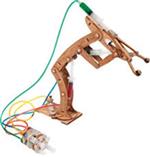The 5 - 8 Science Cycle

Work in science is less restricted to a weekly or monthly schedule. Our work follows a project-based approach and assembles students into teams of 3-4, using process science-skills (observation, recording, measuring, communicating, evaluating, suggesting, illustrating) in working toward a common goal. What this work seeks to find varies, but a presentation of work product requires students to provide hypotheses (claim and evidence) backed by data. This approach is part of a larger philosophy of constructivism, where learning builds incrementally toward ideas for new investigations.
In 5/6, our first area of investigation will be with ecology science. You will study how populations of organisms, communities of animal species, and biotic/abiotic factors work to create the world we have around us. For our study, we'll focus on the Browns River and its characteristics as the basis for our specific study. When we are remote learning, we'll also have textbook learning combined with online experiences to enhance our exposure to ideas. Fieldwork will likely occur after school for those choosing to have an in-person experience collecting specimens.
The scientific method is very important to investigations. Rubrics will be provided for students when starting an investigation. These are extremely important "road maps" to effective and efficient learning. These are regularly reviewed as teams work toward the completion of projects. Self-assessment of finished products are made - then this is done again by the instructor. In this way, the evaluation system provides a comparative basis.
Along the way, students supply incremental work steps. These form formative assessments. Completed projects usually have several options in how culminating work looks; whatever is chosen, the assessment is summative. Google Classroom will be the universal format by which work will be sent out and collected for assessment.
Another tradition is to have every student create a science fair. you will notice that the next item on the webpage list references works involved in choosing and creating a successful science fair.
I am also in the process of developing a second year for our archaeological dig experience. There is a place just off school property where an early 20th-century sap house once stood. Our project will to locate and excavate the site to recapture artifacts from that time. All participants will be given specific and ended training in proper dig technique and recording of work. Remember, any disruption of soil destroys a site as it currently is, so we need to proceed with brains if we get one scientific shot at peeling back the layers of soil to discover our past.
We will also be in our second year of investigating a vernal pool area, located approximately 1.5 kilometres SSE of the school property adjacent to (but not connected to) the Browns River.
Both of these projects have separate web-page sections that can be accessed by clicking on the title from the landing page of this website.
